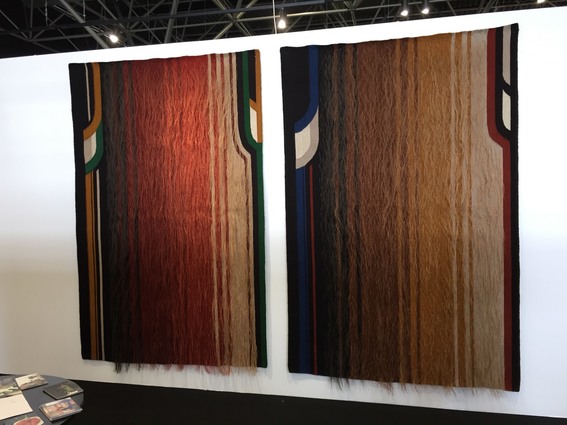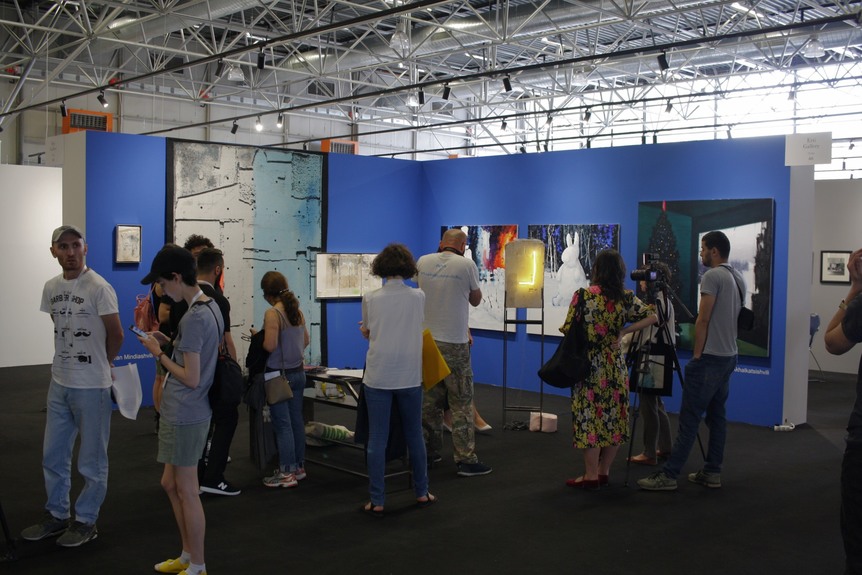
R
E
V N
E
X
T
One of the halls of the Expo Georgia campus where the Tbilisi Art Fair (TAF) was held, with a poster of a drawing by Ivan Yazykov (shown at NK Gallery). All photos by HG Masters for ArtAsiaPacific.
The techno-fueled protests following police raids on the Tbilisi nightclubs Bassiani and Café Gallery put the youth of Georgia in the international spotlight in mid-May. Energetic, alternative, LGBTI-friendly crowds danced in defiance on Rustaveli Avenue outside parliament as riot police tried to prevent counter-demonstrating, neo-fascist and conservative religious groups from attacking them. “This country belongs to us,” the ravers and their allies shouted. “We don’t want another Putin,” signs read, as they demanded the resignation of the prime minister and minister of internal affairs.
That same energy and DIY spirit—as well as echoes of anti-Russian sentiment—carried over into the following week, when local organizations and galleries planned exhibitions and events to coincide with the first edition of the Tbilisi Art Fair (TAF, May 17–20). The Georgian contemporary art scene has been growing in the past few years, with the opening of galleries and new initiatives, as many Georgian artists have returned from cities like Berlin, London and New York, or are spending more time in Tbilisi. But as so often happens, it takes an international event, like an art fair or a biennial, to bring international visitors and to amplify attention—however briefly, in the art world’s busy calendar—on the art scene.
TAF hosted 35 galleries in Hall 11 at Expo Georgia, which is less a convention center and more a campus of buildings and green spaces. Alongside the Tbilisi galleries were spaces from Moscow, Warsaw, Vilnius, Yerevan, Berlin, Paris, Barcelona, Antwerp and Kyrenia (in Northern Cyprus), which made for an interesting geographical network. The most immediate highlight was two textile works (gobelins) by Tamaz Nutsubidze (1940–2002), made in the 1980s as part of the series “Seasons of the Year” and shown at Nectar Gallery’s booth. With vertical rows of shaggy wool dyed in the palettes of autumn and winter, they struck a perfect balance between high-modernist painting and the socialist applied arts.
The current generation of Tbilisi’s artists and galleries were well represented. Located in the prime spot at the entrance to the fair, Erti Gallery’s presentation featured dreamy-looking, realist paintings of a snowman, rabbit and Christmas trees by Tato Akhalkatsishvili and mixed-media sculptural works reflecting urban change and decay by Levan Mindiashvili. There were a few examples of ceramic works from mythology-inspired performance artist Uta Bekaia in the booth, while Bekaia’s larger installation, Inhabitants Of Childhood (2018), was in the Expo Georgia gardens. Window Project gallery showed paintings by Levan Chelidze of haunted-looking figures, as well as a wall of sketch-like still-lifes, with modernist, custom-made table and chairs by Max Machaidze. Valid Foto BCN Gallery brought Masao Yamamoto’s poetic, sepia-tinged, black-and-white photographs. Rita Khachaturian’s expressive, figurative paintings were shown at the booths of both Gallery Container and Vanda Gallery. Raster Gallery featured humorous ceramic objects from Olaf Brzeski and two textile works by Slavs and Tatars, whose interest in cross-cultural, Eurasian and Soviet connections felt right at home in Georgia.
For a first-time art fair, TAF made genuine efforts to offer a wide-range of supplemental exhibitions and projects around the Expo Georgia campus. There was a section called Hive, which was for individual presentations by artists without galleries. In another nearby hall was a display of Georgian photography, “In and Out of Reality,” co-organized with the Tbilisi Photo Festival, with images of Georgia from the 19th century through the modern era, as well as works by contemporary artists. Reactivating a derelict pavilion was the exhibition “War on Hold / Under Construction,” curated by Liza Zhvania, which featured 20 young artists thinking about their privilege of working during a period of “temporary peace.”
At the opening press conference, TAF Founder Kaha Gvelesiani and artistic director Eric Schlosser—who was previously the creative director of the now defunct fair Art Moscow—talked about how they want to transform Tbilisi into a regional art hub. Between the speeches by the fair’s organizers, a representative from the Tbilisi Municipality and then Irena Popiashvili, the dean of the visual art and design program at the Free University of Tbilisi and the co-founder of the new Kunsthalle Tbilisi project, spoke of the desire to create a more open, “European” society.
Schlosser had created controversy, I learned later, by announcing there would be a juried award for artists under 35 in the fair. The prize was to be a residency at the Moscow Museum of Modern Art, a state-run museum originally founded by Georgian artist Zurab Tsereteli, who is a contentious figure, both for his monumental, kitsch sculptures (including of Vladimir Putin in judo wear) and his cosy position as the president of the Russian Academy of Arts, where he amassed a reputed fortune. The dynamic between Georgia and Russia is complicated, caused not only by the 60-plus years of Georgia’s occupation by the USSR, but also the ongoing military occupation of the South Ossetia region, which Russia seized in the 2008 Russo-Georgian War, and the breakaway Abkhazia region, as well as the influx of Russian money and influence on Georgia’s politics and economy. It is immediately evident in the advertising for developments in the Black Sea resort of Batumi and the outsized glass towers that soar along the Mtkvari River that Georgia, too, is a haven for oligarchic capital. The art fair itself banks on wealthy Georgians and many Russian collectors, for whom Georgia is reputed to be an exotic mountain destination for wine and poetry.
After looking at the fair for a few hours, Popiashvili took a group of her international guests over to the Stamba Hotel (a former printing house), where many of her students from Free University’s art program had organized “Oxygen – Tbilisi No Fair,” a parallel event to TAF that ran for four days. Using spaces of the building that haven’t been transformed into a luxury hotel yet, there were 33 individual and two group presentations by young artists. There were some real stand-outs here, most notably Salome Chigilashvili’s floor installation Almost (2018), of stitched fragments embedded in plaster on the floor, resembling a constructivist abstraction, except using the applied arts materials of textiles and mosaics (with echoes in that approach to Tamaz Nutsubidze). The artist is still in university but her piece managed to captivate a crowd of international curators and writers. Thea Gvetadze’s installation, created in collaboration with Gvantsa Sanikidze, with hand-painted, radish-print wallpaper and involving an actual bazaar vegetable seller with a table of herbs, greens and root vegetables, had a very strong visual presence, but was hugely problematic for its inclusion of a migrant worker sitting behind the produce. Lado Lomitashvili’s I Drank Your Holy Water (2018) was a room of red sand with a large, black hand embedded in the soil and other abstract arrangements of objects that formed an allegory about the environmental impact of urbanization. Downstairs, in an area near a restaurant, were projects framed by Vajiko Chachkhiani’s wooden windows (Georgia’s representative at the Venice Biennale in 2017), such as Giorgi Maghradze’s sculpture of a flaccid blue metal see-saw, Social Weightfulness (2015/18). The duo of artist Gvantsa Jishkariani and curator Ellen Kapanadze, operating under the name Why Not Gallery, had boycotted TAF because of the Moscow prize, and showed works by three artists (Salome Machaidze’s figurative drawings, Tamar Botchorishvili’s absurdist, tchotchke-like sculptures, photographer George Nebieridze’s intimate portraits) at “Oxygen” instead.
Later in the weekend, artist Levan Mindiashvili joked with me that he didn’t see why there has to be two of everything in Georgia (because of the Orthodox calendar)—two Christmases, two New Year’s, and now two art fairs. But “Oxygen – Tbilisi No Fair” was a welcome complement to TAF—a more experimental and hip showcase for younger artists than a conventional art fair would allow, even if there was plenty of crossover of artists showing in both “Oxygen” and at TAF or the TAF-supported shows like “War on Hold.”
Along with the launch of TAF was the inauguration of the Kunsthalle Tbilisi, an initiative co-founded by Irena Popiashvili and art consultant Lika Chkuaseli, which for now will organize artist projects at different locations in the city. The first of these to open was Nika Kutateladze’s installation Watermill On Former Pavlov Street (2018), which entailed dissembling a watermill from the region of Guria, where the artist’s family is from, and reinstalling the machinery in a Soviet-era apartment in a residential district of the city, on what used to called Pavlov Street, symbolically collapsing two architectural structures in a metaphor for Georgia’s history.
A second Kunsthalle Tbilisi project, co-organized with Protocinema, was ANGELICA MESITI’s three-channel video Relay League (2017). Here, one dancer guides the body of another who has limited vision, translating the movements of a third performer into a non-verbal language.
The second of Kunsthalle Tbilisi’s presentations was Angelica Mesiti’s three-channel video Relay League (2017), dispersed in three separate spaces inside a winery’s former storage area. The project was co-organized by Mari Spirito’s nomadic organization Protocinema, with Kunsthalle Tbilisi and Sydney’s Artspace, where the videos had originally been commissioned and shown. The work is based on the final Morse code message sent by the French navy on January 31, 1997—“Calling all. This is our final cry before our eternal silence”—which Mesiti, in her introduction to the project, said struck her for both its poetic tone, considering that Morse code is primarily the language of distress and emergency, and the meta-qualities of a language reflecting on itself. Mesiti took the phrase in its Morse code form and gave it to a percussionist and composer Uriel Barthélémi (he performed at the Sharjah Biennial in 2015 in collaboration with two Emirati dancers), who, in the first part of the work, we see using the Morse code phrase as if it were a score, playing a set of drums on a Paris rooftop. From there, dancer and choreographer Felipe Lourenço, who works with Arabic folk music and dance in some of his own performances, uses Barthélémi’s soundtrack to create a new dance. Meanwhile, in the second or third channel (depending on how you navigate the spaces) a pair of Swedish choreographers—Sindri Runudde and Emilia Wibron Vesterlund—are engaged in other acts of translation and non-verbal communication as they watch Lourenço’s dance. Runudde has a degenerative eye disorder, so Vesterlund conveys the dance’s gestures by manipulating Runudde’s limbs and face in a haptic form of translation that eludes familiar comprehension. The beautifully filmed performances require patient viewing to connect the hermetic logic of the three parts. Its reward lies in watching the talent of its performers, who take a mechanized language—of the industrial revolution, global imperialism, colonialism, and the military—and transform it into sounds and gestures that reflect their practices and personal histories of the postcolonial 21st century. Relay League is at once a farewell to one form of communication and a celebration of its potential rebirth in new forms—a spirit of rejuvenation that very much mirrored Tbilisi’s own cycles of transformation.
HG Masters is editor-at-large of ArtAsiaPacific.
To read more articles by ArtAsiaPacific, visit our Digital Library.










